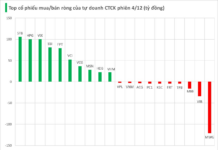Gold price at the end of the week was at $2,040.69 per ounce, up 1.4% for the week; while gold futures for April rose 0.9% to $2,049.4 per ounce. In the past 6 trading sessions, gold prices have increased in 5 sessions, while the Dollar index has decreased in 6 out of 7 recent sessions.
In the domestic market, gold prices have been volatile in recent days, and they have also tended to increase along with global prices. Accordingly, gold prices in the domestic market ended the week fluctuating in the range of 76.25 – 78.7 million dong per tael (buying – selling), an increase of about 100,000 – 300,000 dong compared to 76.15 – 78.42 million dong per tael (buying – selling) a week ago.

World gold price movements.
Dollar index decreased by 0.1% this week, marking the first decline in nearly 2 months after Federal Reserve officials dashed investors’ hopes of an early rate cut. US treasury yields also fell this week, making gold – denominated in USD – cheaper for customers outside the US.
“We are currently in a difficult period in the precious metals market, but there are still many safe-haven bids, despite high interest rates at present,” said Bob Haberkorn, senior market strategist at RJO Futures.
Recent statements from Fed officials have put pressure on gold, but they have not prevented prices from falling as the USD weakens and tensions in the Middle East escalate.
Fed Governor Christopher Waller said on Thursday that there is “no rush” to cut interest rates. Earlier, minutes from the Fed’s January meeting showed that most US policymakers were concerned about the risks of cutting rates too soon. Indeed, recent data shows that US consumer prices and producer prices are higher than expected, further reinforcing the view that interest rates will continue to remain high for some time.
The latest weekly survey results from Kitco News show that retail investors on Wall Street still stick to their predictions of higher gold prices, but they believe that the market will be quieter as it enters the last week of February. Meanwhile, Wall Street analysts have abandoned their recent ambivalence and become more optimistic.
Adrian Day, Chairman of Adrian Day Asset Management, is among those predicting further gold price increases next week. He said, “After considering signs that the Fed will postpone interest rate cuts, the market is now ignoring those issues.” “Fundamental principles of the gold market are positive and supportive of prices.”
James Stanley, senior market strategist for Forex.com, said, “I still maintain a ‘bullish’ stance for next week.” “USD investors were pleased by last week’s CPI report, but the USD still declined. Core CPI has hovered around 4% for the past 5 months, but the Fed has played down the impact of this figure, which is very significant, suggesting that the Fed does not actually want to maintain a tight stance despite inflation data not meeting expectations. And the market’s reaction so far seems to agree with that.” “On the other hand, the European Central Bank has retained its view on interest rate cuts. That may put similar pressure on the USD next week, and I expect it to be a positive impact on gold.”
However, Adam Button, head of currency strategy at Forexlive.com, has a different view of the possible reaction of the Fed to hot inflation data. He said, “If we get some more surprises in upbeat economic data, the Fed will start losing its dovish bias.” “In that case, gold could see a considerable decline.”
Bob Haberkorn, senior commodities broker at RJO Futures, said, “The biggest risk for gold right now is if we receive hot inflation data once again, because most of the gold price increases right now come from buying safe assets, seeking safe assets, but also with expectations that the Fed will soon cut rates.” “The latest monthly data has pushed those expectations further away, to June, but in reality it may be even further away, say September.”
Haberkorn said gold has formed a good price base, around $2,000 per ounce. “Gold has fallen below this threshold a few times, but because of the geopolitical risks that can occur, along with the US election this year and expectations of a Fed rate cut, gold has remained at that level.” According to him, a good support level is $2,000, and “Whenever the price drops below that level, it is quickly pushed back up due to buying activity.”
He said that next week, the main thing that gold traders need to watch is the bond yields and US stocks. He said, “The strength of the US stock market really limits what gold can do this week.” “It is an unfavorable environment for gold, when investors accept risk. I think PCE data and any speeches from the Fed next week on rate hikes or cuts will all impact gold at this time. I expect gold to remain within the current range after the next Fed announcements.”
Haberkorn believes that the upcoming Fed speakers will still be consistent in their messages. He said, “If any of them hint at something related to cutting rates sooner, that would be extremely beneficial for gold investors at this time.” “But what’s quite impressive is that gold has been able to maintain the $2,000 level when our interest rates are currently at high levels. This shows that global investors at this time are very concerned about risks.”
For next week, the information that gold investors need to follow is the US PCE price index, to be announced on Thursday (February 29) – the main inflation gauge used by the Fed; new home sales, announced on Monday (February 26); durable goods orders and US consumer confidence to be announced on Tuesday (February 27); the preliminary Q4 GDP report for the US, to be announced on Wednesday (February 28); pending home sales to be announced on Thursday (February 28); and the ISM manufacturing PMI index to be announced on Friday (February 29).
Reference: Kitco News





































